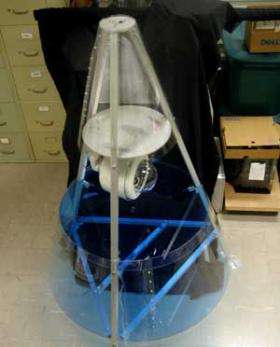Robot Cameras in the Wild

Almost every night, cars are broken into in Yosemite National Park. It's classic smash-and-dash. Windows are shattered and goods stolen. It's not a human crime ring though. The thieves are black bears and they're mostly after food that visitors leave in their vehicles. Soon though, a new telerobotic surveillance system that enables visitors to "tour" the park via the Internet may also help capture footage of the bear burglars. The installation would be a proof-of-concept test for the Collaborative Observatories for Natural Environments (CONE) technology that UC Berkeley robotics professor Ken Goldberg is developing to aid scientists studying natural animal behavior in remote places.
"Biologists spend a great deal of time observing and recording nature using traditional video equipment," says Goldberg, who holds a joint appointment in the Department of Industrial Engineering and Operations Research and also Electrical Engineering and Computer Sciences. "So we're trying to help them bring the latest technology into the field."
Right now, the study of animals in the wild over long periods can be difficult, expensive, and sometimes dangerous. For example, scientists would like to watch families of Alaskan polar bears emerging from their dens in the spring. While it's fine weather for bears, humans aren't accustomed to the whipping winds and freezing cold.
Working with his former graduate student Dezhen Song, now a professor at Texas A&M University, Goldberg is designing robotic "observatories" that scientists could leave behind at their research sites. Once they return to the laboratory, they could log on to the Internet to see what the camera see and steer it to keep an eye on their animal subjects from afar. The system draws from advances in high-resolution robotic cameras, long-range wireless networking, distributed sensor networks, and software algorithms for collaborative control that Goldberg and Song developed in the last few years.
The idea, Goldberg explains, is that the CONE would be contained in a small, wheeled trunk. After opening the lid, the system automatically kicks into operation, seeking out a satellite connection for Internet access and charging its batteries via solar panels. Meanwhile, the scientist distributes a handful of small, wireless sensors (pioneered at UC Berkeley) that monitor motion, temperature, and other variables. T he sensors self-organize into an ad hoc wireless network and pass their data from one to another, bucket-brigade style until the information reaches the CONE.
Depending on what the sensors detect, the telerobotic camera can then point itself at the source of the activity – for example, unusual movement off to one side of the panorama. The system might then create a time-lapse clip of that specific region for later review by the scientist.
What happens if more than one sensor calls for the camera's attention, or more than one scientist commands it to move simultaneously? That's when Goldberg and Song's advanced control algorithms kick in. The software uses mathematical principles to infer a consensus from a group of requests. That way, the observatory can point the camera in the direction that will satisfy the most users all of the time. They're also working on a time-based technique for the camera to respond in turn to each request as efficiently as possible.
"It's a hybrid system though, so it's collaborative not just among people but also among sensors," Goldberg says. "A change in the image can be requested by people or sensors and that request can be weighted depending on who or what is making it. If the chief biologist wants to see something, her request can override everything else."
Currently, Goldberg and Song are working with the National Geographic Society on a plan to test their prototype CONE in Yosemite in the near future. They've also begun to discuss more scientific collaborations with UC Berkeley biologists. In the short term though, the technology may soon save visitors from facing the reality that animals can be criminals too.
"The rangers want to show people what can happen if they leave food in their cars," Goldberg says. "Of course, viewers safe at home may enjoy watching the brutes at work: Go Bears!"
Source: UC Berkeley College of Engineering, Lab Notes, by David Pescovitz

















